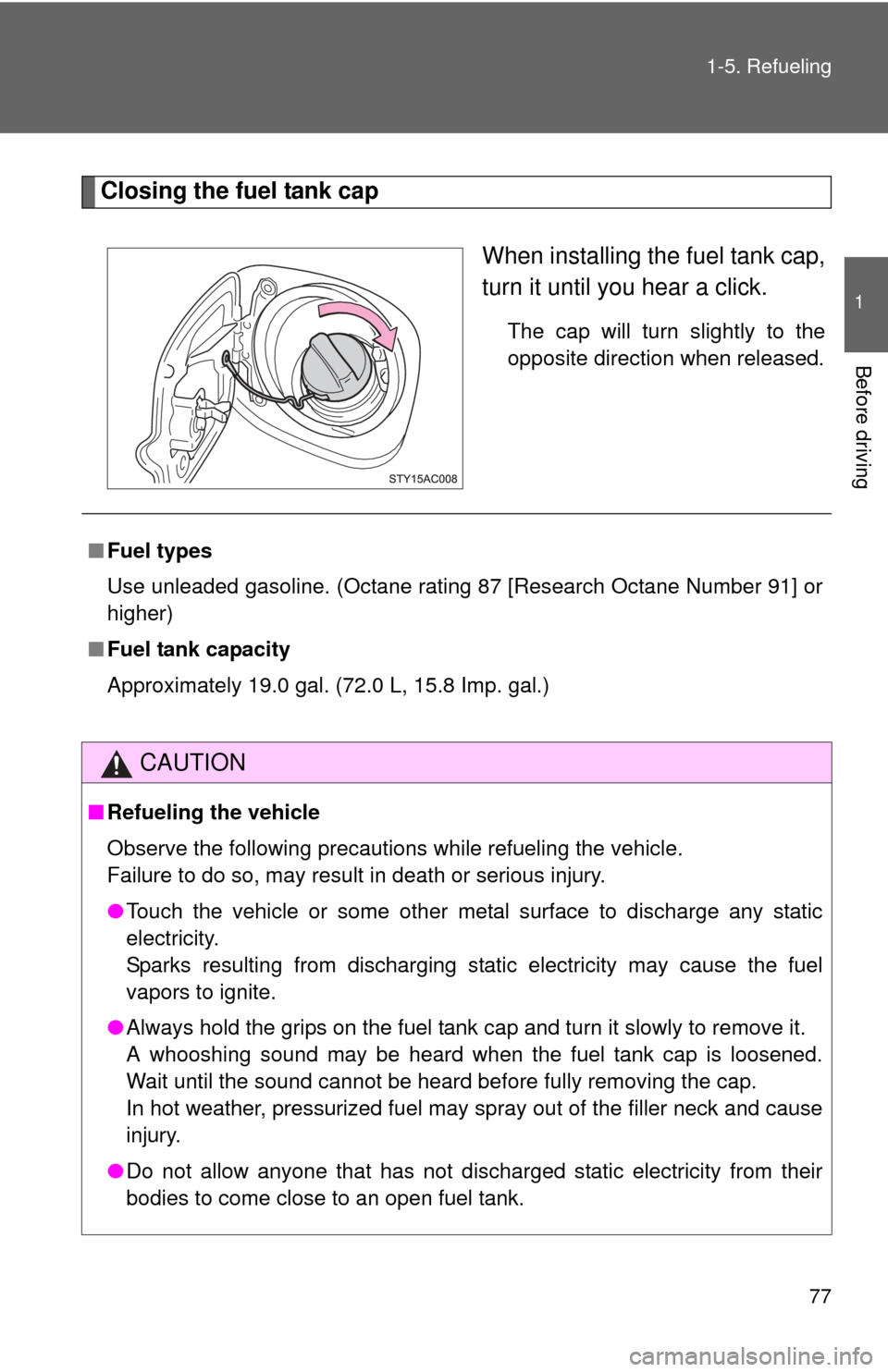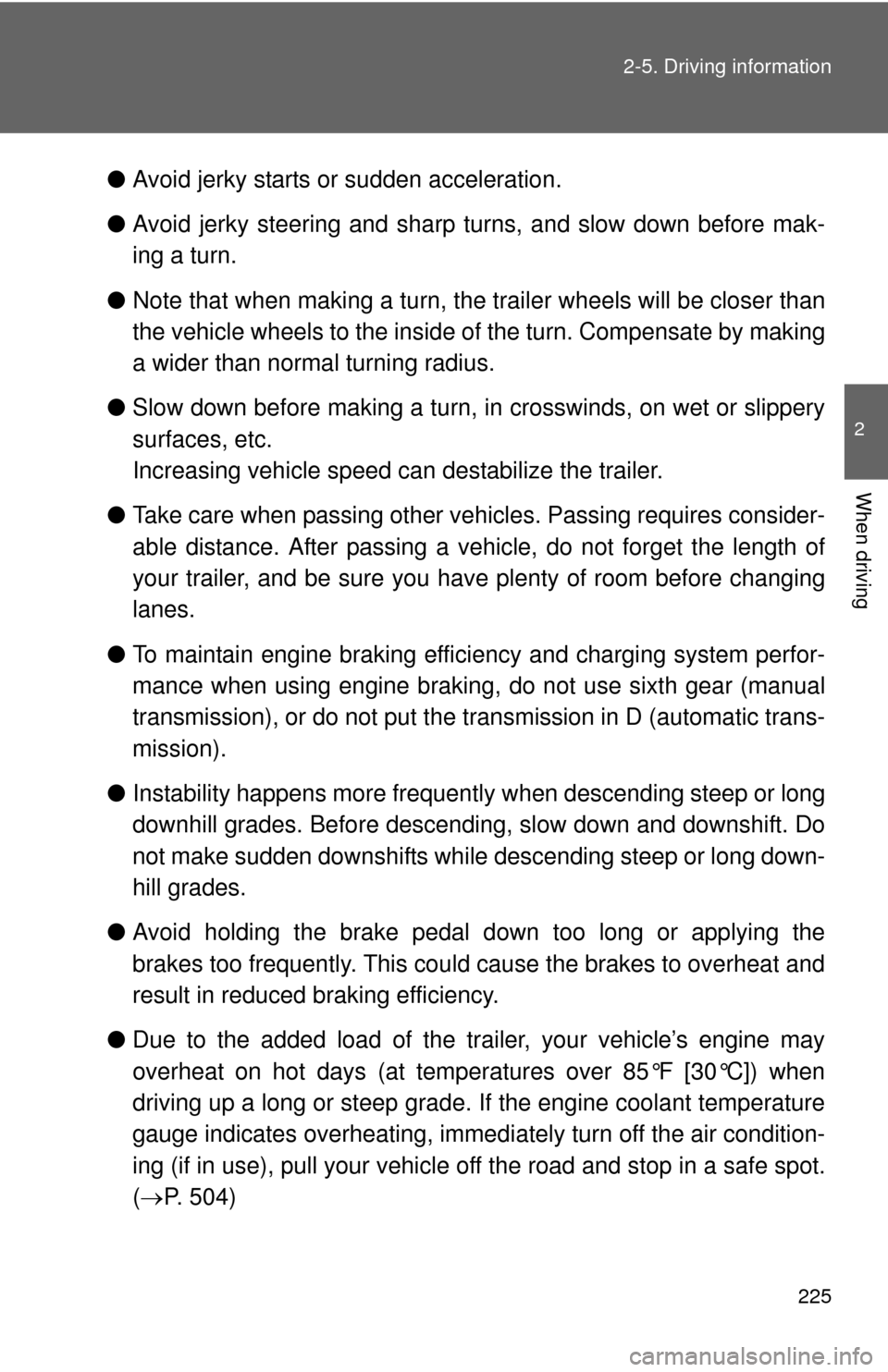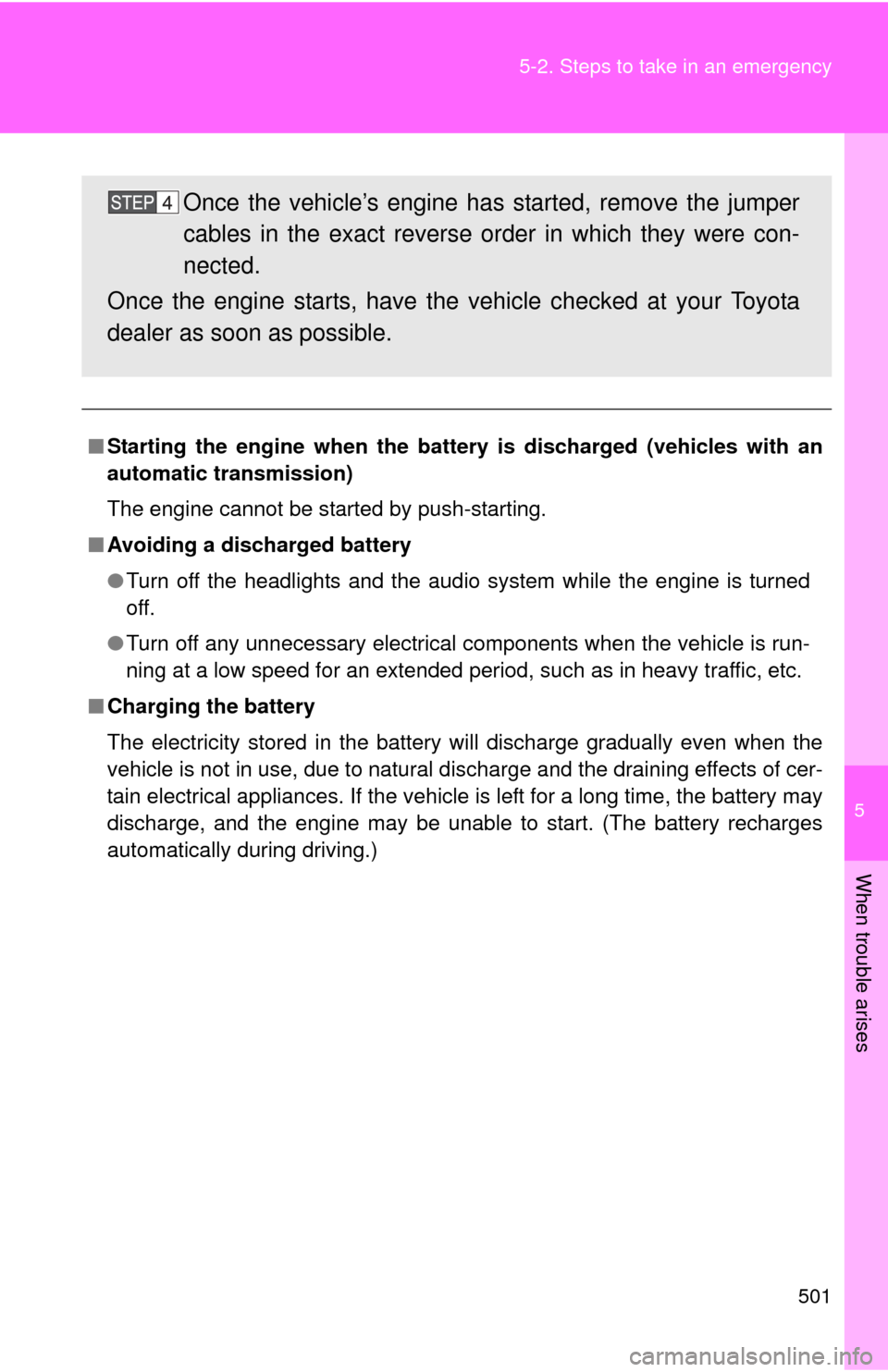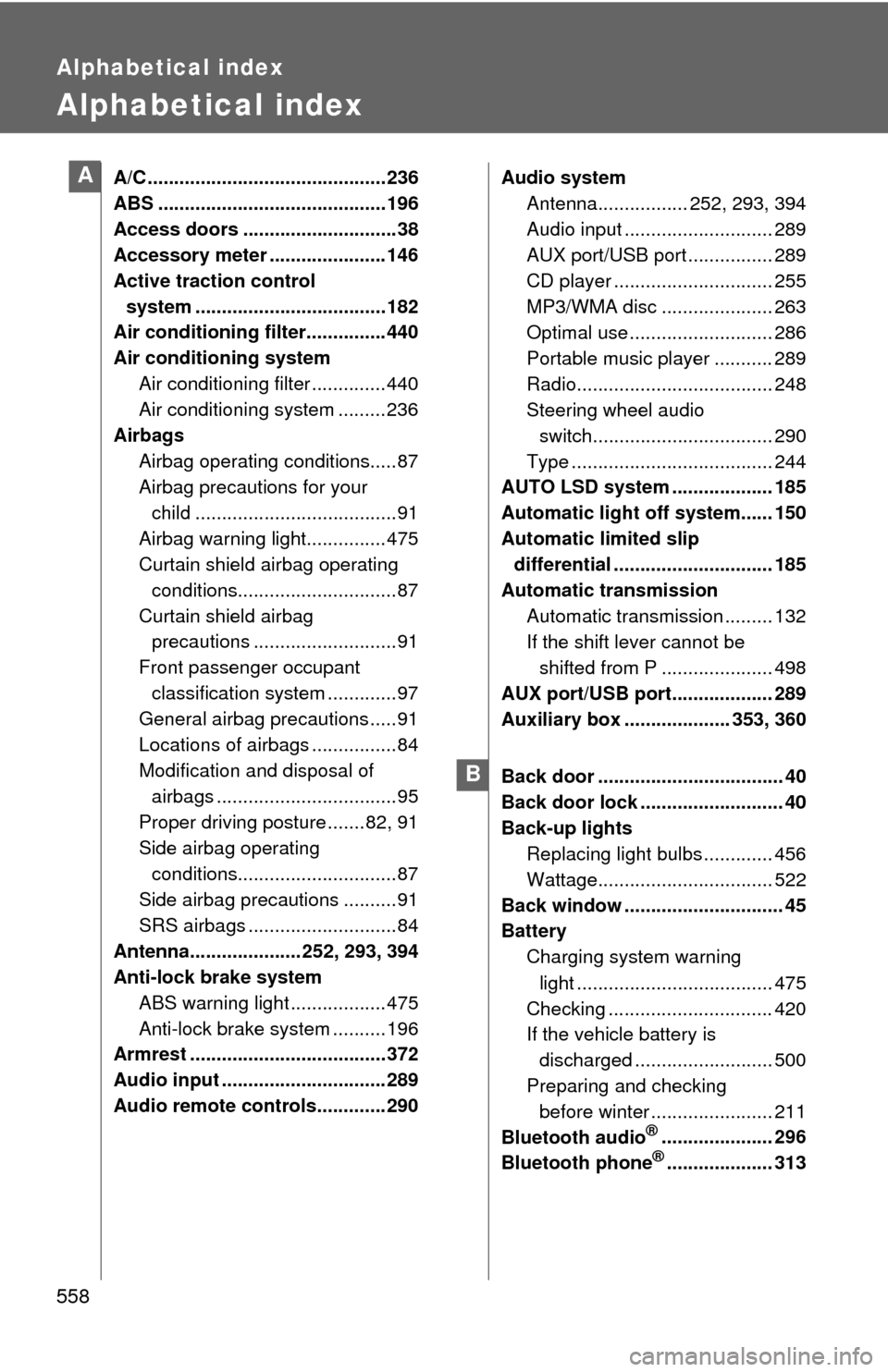charging TOYOTA FJ CRUISER 2014 1.G Owners Manual
[x] Cancel search | Manufacturer: TOYOTA, Model Year: 2014, Model line: FJ CRUISER, Model: TOYOTA FJ CRUISER 2014 1.GPages: 572, PDF Size: 9.45 MB
Page 77 of 572

77
1-5. Refueling
1
Before driving
Closing the fuel tank cap
When installing the fuel tank cap,
turn it until you hear a click.
The cap will turn slightly to the
opposite direction when released.
■Fuel types
Use unleaded gasoline. (Octane rating 87 [Research Octane Number 91] or
higher)
■ Fuel tank capacity
Approximately 19.0 gal. (72.0 L, 15.8 Imp. gal.)
CAUTION
■Refueling the vehicle
Observe the following precautions while refueling the vehicle.
Failure to do so, may result in death or serious injury.
●Touch the vehicle or some other metal surface to discharge any static
electricity.
Sparks resulting from discharging static electricity may cause the fuel
vapors to ignite.
● Always hold the grips on the fuel tank cap and turn it slowly to remove it.
A whooshing sound may be heard when the fuel tank cap is loosened.
Wait until the sound cannot be heard before fully removing the cap.
In hot weather, pressurized fuel may spray out of the filler neck and cause
injury.
● Do not allow anyone that has not discharged static electricity from their
bodies to come close to an open fuel tank.
Page 225 of 572

225
2-5. Driving information
2
When driving
●
Avoid jerky starts or sudden acceleration.
● Avoid jerky steering and sharp turns, and slow down before mak-
ing a turn.
● Note that when making a turn, th e trailer wheels will be closer than
the vehicle wheels to the inside of the turn. Compensate by making
a wider than normal turning radius.
● Slow down before making a turn, in crosswinds, on wet or slippery
surfaces, etc.
Increasing vehicle speed can destabilize the trailer.
● Take care when passing other vehicles. Passing requires consider-
able distance. After passing a vehicle, do not forget the length of
your trailer, and be sure you hav e plenty of room before changing
lanes.
● To maintain engine braking efficiency and charging system perfor-
mance when using engine braking, do not use sixth gear (manual
transmission), or do not put the transmission in D (automatic trans-
mission).
● Instability happens more frequently when descending steep or long
downhill grades. Before descending, slow down and downshift. Do
not make sudden downshifts while descending steep or long down-
hill grades.
● Avoid holding the brake pedal down too long or applying the
brakes too frequently. This could cause the brakes to overheat and
result in reduced braking efficiency.
● Due to the added load of the trailer, your vehicle’s engine may
overheat on hot days (at temperatures over 85°F [30°C]) when
driving up a long or steep grade. If the engine coolant temperature
gauge indicates overheating, immedi ately turn off the air condition-
ing (if in use), pull your vehicle off the road and stop in a safe spot.
( P. 504)
Page 421 of 572

421
4-3. Do-it-yourself maintenance
4
Maintenance and care
■
Checking battery fluid
Check that the level is between
the upper line and the lower line.
Upper line
Lower line
If the fluid level is at or below the
lower line, add distilled water.
■Adding distilled water
Remove the vent plug.
Add distilled water.
If the upper line cannot be seen, check the fluid level by looking
directly at the cell.
Put the vent plug back on and close securely.
Low O.K.
■Before recharging
When recharging, the battery produces hydrogen gas which is flammable
and explosive. Therefore, before recharging:
●If recharging with the battery installed on the vehicle, be sure to discon-
nect the ground cable.
● Make sure the power switch on the charger is off when connecting and
disconnecting the charger cables to the battery.
Page 423 of 572

423
4-3. Do-it-yourself maintenance
4
Maintenance and care
Washer fluid
If the washer fluid level is at
LOW, add washer fluid.
NOTICE
■When recharging the battery
Never recharge the battery while the engine is running. Also, be sure all
accessories are turned off.
■ When adding distilled water
Avoid overfilling. Water spilled during battery recharging may cause corro-
sion.
■Using the gauge
The washer fluid level can be checked by
observing the position of the level on the
liquid-covered holes in the gauge.
If the level falls below the second hole
from the bottom (the LOW position), refill
the washer fluid.
Current
fluid level
Page 451 of 572

451
4-3. Do-it-yourself maintenance
4
Maintenance and care
18 DOME
10 AInterior light, personal lights,
engine switch light, clock, acces-
sory meter, meter and gauge
19 RADIO NO.1 20 A Audio system
20 ECU-B 10 AAir conditioning system, multiplex
communication system, SRS air-
bag system, front passenger occu-
pant classification system, garage
door opener, Crawl Control system
21 ALT-S 7.5 A Charging system
22 AI-VSV 10 A AI system
23 HORN 10 A Horn
24 A/F HEATER 15 A Multiport fuel injection system/
sequential multiport fuel injection
system
25 TRN-HAZ 15 ATurn signal lights, emergency
flashers
26 ETCS 10 AMultiport fuel injection system/
sequential multiport fuel injection
system, electronic throttle control
system
27 EFI 20 AEFI NO.2, multiport fuel injection
system/sequential multiport fuel
injection system
28 DR/LCK 20 ADoor lock system, multiplex com-
munication system
29 TOWING 15 A Towing converter
30 RADIO NO.2 20 A Audio system
31 AIR PMP 50 A AI system
32 AM1 50 AACC, ECU-IG, IG1, RR WSH, FR
WIP-WSH, 4WD/DIFF and STA
33 J/B 50 A TAIL, PWR OUTLET, POWER
FuseAmpereCircuit
Page 454 of 572

454 4-3. Do-it-yourself maintenance
7 ECU-IG10 AAnti-lock brake system, vehicle sta-
bility control system, traction con-
trol system, active traction control
system, AUTO LSD system, cruise
control system, back door lock sys-
tem, shift lock system, multiplex
communication system, tire pres-
sure warning system, Crawl Con-
trol system
8 IG1 15 ATurn signal lights, air conditioning
system, charging system, clutch
start cancel switch, anti-lock brake
system, traction control system,
active traction control system, vehi-
cle stability control system, AUTO
LSD system, back-up lights, intui-
tive parking assist, rear differential
lock system, power outlet, acces-
sory meter, meter and gauge, rear
view monitor system
9 STA 7.5 AStarting system, clutch start cancel
switch, power outlet
10 TAIL 10 ATail lights, license plate lights, park-
ing lights, instrument panel light
control, illuminations
11 A C C 7 . 5 AShift lock system, outside rear view
mirrors, audio system, power out-
let, clock, accessory meter, multi-
plex communication system
12 POWER 30 A Power windows
FuseAmpereCircuit
Page 475 of 572

5
When trouble arises
475
5-2. Steps to take in an emergency
Stop the vehicle immediately.
The following warnings indicate the possibility of damage to the vehi-
cle that may lead to an accident. Immediately stop the vehicle in a
safe place and contact your Toyota dealer.
*: The light may come on when the oil level is extremely low. It is not designed to indicate low oil level, and the oil level must be checked using the engine
oil level dipstick.
Have the vehicle inspected immediately.
Failing to investigate the cause of the following warnings may lead to
the system operating abnormally and possibly cause an accident.
Have the vehicle inspected by your Toyota dealer immediately.
Warning lightWarning light/Details
Charging system warning light Indicates a malfunction in the vehicle’s charging sys-
tem.
Low engine oil pressure warning light Indicates that the engine oil pressure is too low
*.
Warning lightWarning light/Details
(U.S.A.)
(Canada) Malfunction indicator lamp
Indicates a malfunction in:
• The electronic engine control system;
• The electronic throttle control system;
• The electronic automatic transmission control sys-tem; or
• Emission control system.
Page 501 of 572

5
When trouble arises
501
5-2. Steps to take in an emergency
■
Starting the engine when the battery is discharged (vehicles with an
automatic transmission)
The engine cannot be started by push-starting.
■ Avoiding a discharged battery
●Turn off the headlights and the audio system while the engine is turned
off.
● Turn off any unnecessary electrical components when the vehicle is run-
ning at a low speed for an extended period, such as in heavy traffic, etc.
■ Charging the battery
The electricity stored in the battery will discharge gradually even when the
vehicle is not in use, due to natural discharge and the draining effects of cer-
tain electrical appliances. If the vehicle is left for a long time, the battery may
discharge, and the engine may be unable to start. (The battery recharges
automatically during driving.)
Once the vehicle’s engine has started, remove the jumper
cables in the exact reverse order in which they were con-
nected.
Once the engine starts, have the vehicle checked at your Toyota
dealer as soon as possible.
Page 517 of 572

517
6-1. Specifications
6
Vehicle specifications
Ignition system
Electrical system
Spark plug
Make DENSO SK16HR11
Gap
0.043 in. (1.1 mm)
NOTICE
■Iridium-tipped spark plugs
Use only iridium-tipped spark plugs. Do not adjust gap when tuning engine.
Battery
Open voltage at
68 F (20 C) 12.6 12.8 V Fully charged
12.2 12.4 V Half charged
11 . 8
12.0 V Discharged
(Voltage checked 20 minutes after the key is
removed with all the lights turned off)
Charging rates 5 A max.
Page 558 of 572

558
Alphabetical index
Alphabetical index
A/C ............................................. 236
ABS ........................................... 196
Access doors .............................38
Accessory meter ...................... 146
Active traction control system .................................... 182
Air conditioning filter............... 440
Air conditioning system
Air conditioning filter .............. 440
Air conditioning system ......... 236
Airbags Airbag operating conditions.....87
Airbag precautions for your child ......................................91
Airbag warning light............... 475
Curtain shield airbag operating conditions..............................87
Curtain shield airbag precautions ...........................91
Front passenger occupant classification system .............97
General airbag precautions .....91
Locations of airbags ................84
Modification and disposal of airbags ..................................95
Proper driving posture .......82, 91
Side airbag operating conditions..............................87
Side airbag precautions ..........91
SRS airbags ............................84
Antenna..................... 252, 293, 394
Anti-lock brake system
ABS warning light .................. 475
Anti-lock brake system .......... 196
Armrest ..................................... 372
Audio input ............................... 289
Audio remote controls............. 290 Audio system
Antenna................. 252, 293, 394
Audio input ............................ 289
AUX port/USB port ................ 289
CD player .............................. 255
MP3/WMA disc ..................... 263
Optimal use ........................... 286
Portable music player ........... 289
Radio..................................... 248
Steering wheel audio switch.................................. 290
Type ...................................... 244
AUTO LSD system ................... 185
Automatic light off system...... 150
Automatic limited slip differential .............................. 185
Automatic transmission Automatic transmission ......... 132
If the shift lever cannot be shifted from P ..................... 498
AUX port/USB port................... 289
Auxiliary box .................... 353, 360
Back door ................................... 40
Back door lock ........................... 40
Back-up lights Replacing light bulbs ............. 456
Wattage................................. 522
Back window .............................. 45
Battery Charging system warning light ..................................... 475
Checking ............................... 420
If the vehicle battery is discharged .......................... 500
Preparing and checking before winter ....................... 211
Bluetooth audio
®..................... 296
Bluetooth phone®.................... 313
A
B